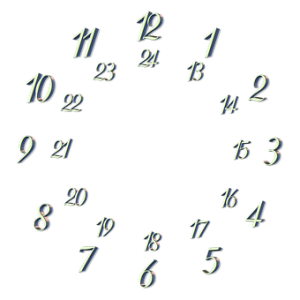4.10 24-Hour Clock
When reading or recording time according to the 24-hour clock, the hours are counted from one to twenty-four, and the minutes from one to fifty-nine. The 24-hour clock is used in all areas of health care to avoid confusion and errors.
There are always four digits in the number when stating the time using a 24-hour clock. The first two digits indicate the hour, and the second two digits indicate the minutes. The use of a.m. and p.m. is unnecessary. A few examples and explanations are given below:
- Morning hours are 0000 hours to 1200 hours. Note that 0000 hours (zero-hundred hours) is midnight, and 1200 hours (twelve-hundred hours) is noon.
- Afternoon hours are 1200 hours to 2400 hours. Note that 1200 hours (twelve-hundred hours) is noon, and 2400 hours (twenty-four-hundred hours) is midnight.
- 1000 (ten-hundred hours) means 10 o’clock in the morning.
- 2230 hours (twenty-two-thirty hours) means 10:30 in the evening.
Fig. 4.23 is an image of a 24-hour clock. Midnight would be 2400, and five minutes after midnight would be written as 0005. All the standard times with the corresponding 24-hour clock times are listed in Tables 4.39 and 4.40.

Table 4.39. 24-Hour Clock (1 a.m. – Noon)
| STANDARD TIME | 24-HOUR CLOCK |
| 1:00 a.m. | 0100 hours |
| 2:00 a.m. | 0200 hours |
| 3:00 a.m. | 0300 hours |
| 4:00 a.m. | 0400 hours |
| 5:00 a.m. | 0500 hours |
| 6:00 a.m. | 0600 hours |
| 7:00 a.m. | 0700 hours |
| 8:00 a.m. | 0800 hours |
| 9:00 a.m. | 0900 hours |
| 10:00 a.m. | 1000 hours |
| 11:00 a.m. | 1100 hours |
| 12:00 noon | 1200 hours |
Table 4.40. 24-Hour Clock (1 p.m. – Midnight)
| STANDARD TIME | 24-HOUR CLOCK |
| 1:00 p.m. | 1300 hours |
| 2:00 p.m. | 1400 hours |
| 3:00 p.m. | 1500 hours |
| 4:00 p.m. | 1600 hours |
| 5:00 p.m. | 1700 hours |
| 6:00 p.m. | 1800 hours |
| 7:00 p.m. | 1900 hours |
| 8:00 p.m. | 2000 hours |
| 9:00 p.m. | 2100 hours |
| 10:00 p.m. | 2200 hours |
| 11:00 p.m. | 2300 hours |
| 12:00 midnight | 2400 or 0000 |
(Snow, 2016)
Roman Numerals
Lowercase Roman numerals are occasionally used in medical terminology. You will most frequently see Roman numerals used in medication orders documentation and possibly for some laboratory tests.
Lowercase Roman Numerals
Table 4.41 lists lowercase Roman numerals up to 10. You will most likely see the numerals i to iii used in medical orders.
Table 4.41. Roman Numerals
| STANDARD NUMBER | LOWERCASE ROMAN NUMERAL |
| 1 | i |
| 2 | ii |
| 3 | iii |
| 4 | iv |
| 5 | v |
| 6 | vi |
| 7 | vii |
| 8 | viii |
| 9 | ix |
| 10 | x |
Key Concepts
Examples of orders:
- Polysporin eye gtts i–ii gtts in each eye bid at 0800 and 2000.
- Ventolin nebs x ii tid (0600, 1400, and 2200).
Explanation of orders:
- Polysporin eye drops, one to two drops in each eye twice a day at 8 o’clock in the morning and 8 o’clock in the evening.
- Ventolin two nebules three times a day at 6 o’clock in the morning, 2 o’clock in the afternoon, and 10 o’clock in the evening.
Exercise
Attribution
Unless otherwise indicated, material on this page has been adapted from the following resource:
Carter, K., & Rutherford, M. (2020). Building a medical terminology foundation. eCampusOntario. https://ecampusontario.pressbooks.pub/medicalterminology/ licensed under CC BY 4.0
References
Snow, M. A. (2016, January 8). Nursing assistant: 24 hour clock time [Video]. YouTube. https://www.youtube.com/watch?v=B3sPaYs24Oo
Image Credits (images are listed in order of appearance)

